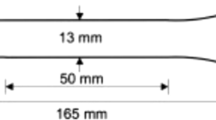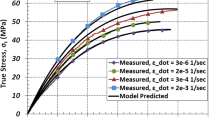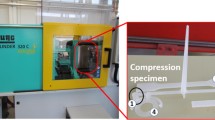Abstract
Observations are reported on isotactic polypropylene in uniaxial tensile tests with various strain rates, relaxation tests with various strains, and creep tests with various stresses at ambient temperature. Constitutive equations are derived for the viscoelastic–viscoplastic responses and damage of a semicrystalline polymer at three-dimensional deformations. Adjustable parameters in the stress–strain relations are found by fitting the experimental data. The model is applied to predict creep-failure diagrams in the entire interval of stresses. A phenomenological approach is proposed to determine a knee stress, at which transition occurs from ductile to brittle rupture. Accuracy of this method is evaluated by numerical simulation.
Similar content being viewed by others
References
Alwis KGNC, Burgoyne CJ (2006) Time-temperature superposition to determine the stress-rupture of aramid fibres. Appl Compos Mater 13: 249–264
Alwis KGNC, Burgoyne CJ (2008) Accelerated creep testing for aramid fibres using the stepped isothermal method. J Mater Sci 43: 4789–4800
Bergstrom JS, Kurtz SM, Rimnac CM, Edidin AA (2002) Constitutive modeling of ultra-high molecular weight polyethylene under large-deformation and cyclic loading conditions. Biomaterials 23: 2329–2343
Bauwens-Crowet C, Ots J-M, Bauwens J-C (1974) The strain-rate and temperature dependence of yield of polycarbonate in tension, tensile creep and impact tests. J Mater Sci 9: 1197–1201
Barton SJ, Cherry BW (1979) Predicting the creep rupture life of polyethylene pipe. Polym Eng Sci 19: 590–595
Ben Hadj Hamouda H, Simoes-Betbeder M, Grillon F, Blouet P, Billon N, Piques R (2001) Creep damage mechanisms in polyethylene gas pipes. Polymer 42: 5425–5437
Ben Hadj Hamouda H, Laiarinandrasana L, Piques R (2007) Fracture mechanics global approach concepts applied to creep slow crack growth in a medium density polyethylene (MDPE). Eng Fracture Mech 74: 2187–2204
Bodner SR (1992) Unified plasticity for engineering applications. Kluwer, New York
Brueller OS (1981) Energy-related failure criteria of thermoplastics. Polym Eng Sci 21: 145–150
Bueno BS, Costanzi MA, Zornberg JG (2005) Conventional and accelerated creep tests on nonwoven needle-punched geotextiles. Geosynth Int 12: 276–287
Cai H, Miyano Y, Nakada M, Ha SK (2008) Long-term fatigue strength prediction of CFRP structure based on micromechanics of failure. J Compos Mater 42: 825–844
Derrida B (1980) Random-energy model: limit of a family of disordered models. Phys Rev Lett 45: 79–92
Golub VP, Pogrebnyak AD, Chernetskaya EV (2000) The kinetics of creep embrittlement under long-term static loading. Int Appl Mech 36: 795–802
Greenwood GW (1976) Fracture under creep conditions. Mater Sci Engng 25: 241–245
Greenwood GW (1990) Mechanistic interpretations of some empirical correlations in creep and creep fracture. ISIJ Int 30: 795–801
Guedes RM (2006) Lifetime predictions of polymer matrix composites under constant or monotonic load. Composites A 37: 703–715
Holmstrom S, Auerkari P (2008) Effect of short-term data on predicted creep rupture life–Pivoting effect and optimized censoring. Mater High Temp 25: 103–109
Janssen RPM, Govaert LE, Meijer HEH (2008) An analytical method to predict fatigue life of thermoplastics in uniaxial loading: sensitivity to wave type, frequency, and stress amplitude. Macromolecules 41: 2531–2540
Kachanov LM (1999) Rupture time under creep conditions. Int J Fracture 97: 11–18
Kaliske M, Nasdala L, Rothert H (2001) On damage modelling for elastic and viscoelastic materials at large strain. Comp Struct 79: 2133–2141
Klompen ETJ, Engels TAP, van Breemen LCA, Schreurs PJG, Govaert LE, Meijer HEH (2005) Quantitative prediction of long-term failure of polycarbonate. Macromolecules 38: 7009–7017
Kolarik J, Pegoretti A (2006) Non-linear tensile creep of polypropylene: Time-strain superposition and creep prediction. Polymer 47: 346–356
Kongkitkul W, Tatsuoka F (2007) A theoretical framework to analyse the behaviour of polymer geosynthetic reinforcement in temperature-accelerated creep tests. Geosynth Int 14: 23–38
Krishnaswamy RK (2005) Analysis of ductile and brittle failures from creep rupture testing of high-density polyethylene (HDPE) pipes. Polymer 46: 11664–11672
Krishnaswamy RK (2007) Influence of wall thickness on the creep rupture performance of polyethylene pipe. Polym Eng Sci 47: 516–521
Leckie FA, Hayherst DR (1974) Creep rupture of structures. Proc Roy Soc London A 340: 323–347
Levesque M, Derrien K, Baptiste D, Gilchrist MD (2008) On the development and parameter identification of Schapery-type constitutive theories. Mech Time-Dependent Mater 12: 95–127
Little RE, Mitchell WJ, Mallick PK (1995) Tensile creep and creep rupture of continuous strand mat polypropylene composites. J Compos Mater 29: 2215–2217
Lin RC, Schomburg U (2003) A finite elastic-viscoelastic-elastoplastic material law with damage: theoretical and numerical aspects. Comp Meth Appl Mech Engng 192: 1591–1627
Lu X, Brown N (1990) The transition from ductile to slow crack growth failure in a copolymer of polyethylene. J Mater Sci 25: 411–416
Lu X, Brown N (1991) Unification of ductile failure and slow crack growth in an ethylene-octene copolymer. J Mater Sci 26: 612–620
Marklund E, Eitzenberger J, Varna J (2008) Nonlinear viscoelastic viscoplastic material model including stiffness degradation for hemp/lignin composites. Compos Sci Technol 68: 2156–2162
Mishnaevsky L, Brondsted P (2008) Micromechanical modeling of damage and fracture of unidirectional fiber reinforced composites: A review. Comput Mater Sci 44: 1351–1359
Orifici AC, Herszberg I, Thomson RS (2008) Review of methodologies for composite material modelling incorporation failure. Comp Struct 86: 194–210
Schapery RA (1999) Nonlinear viscoelastic and viscoplastic constitutive equations with growing damage. Int J Fracture 97: 33–66
Simo JC (1987) On a fully three-dimensional finite-strain viscoelastic damage model: Formulation and computational aspects. Comp Meth Appl Mech Engng 60: 153–173
Tanaka F, Edwards SF (1992) Viscoelastic properties of physically cross-linked networks. Transient network theory. Macromolecules 25: 1516–1523
Teoh SH, Cherry BW, Kaush HH (1992) Creep rupture modelling of polymers. Int J Damage Mech 1: 245–256
Wang XC, Habraken AM (1996) An elastic-visco-plastic damage model: from theory to applications. J Phys IV C 6: 549–558
Zhurkov SN (1964) Kinetic concept of the strength of solids. Int J Fracture Mech 1: 311–323
Zornberg JG, Byler BR, Knudsen JW (2004) Creep of geotextiles using time-temperature superposition methods. J Geotech Geoenviron Eng 130: 1158–1168
Author information
Authors and Affiliations
Corresponding author
Rights and permissions
About this article
Cite this article
Drozdov, A.D., Christiansen, J.d. Creep failure of polypropylene: experiments and constitutive modeling. Int J Fract 159, 63–79 (2009). https://doi.org/10.1007/s10704-009-9384-x
Received:
Accepted:
Published:
Issue Date:
DOI: https://doi.org/10.1007/s10704-009-9384-x




